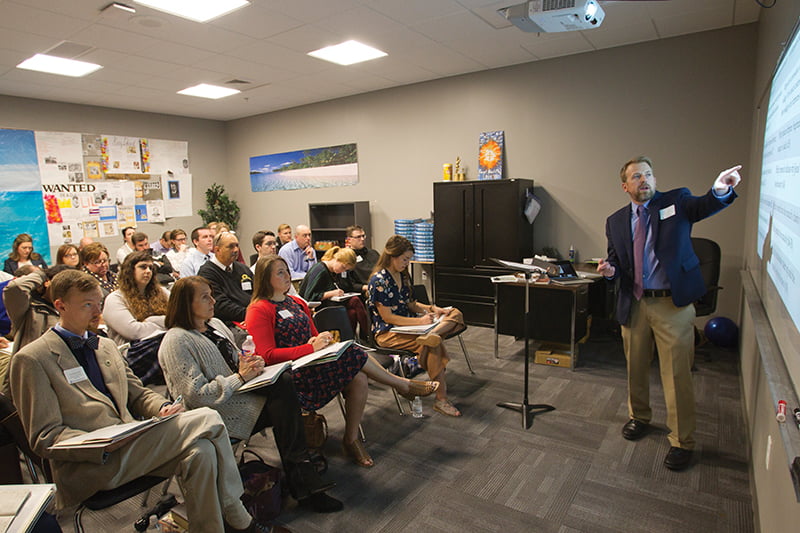
Ben Akers, associate professor of theology at the Augustine Institute in Greenwood Village, Colorado, gives a breakout session entitled: “Teach Us to Pray: A Strategic Approach to Inspiring Active Participation in the Christian Life.” The session explored the church’s teaching on how to encourage student engagement in prayer. LEAVEN PHOTO BY JAY SOLDNER
by Olivia Martin
olivia.martin@theleaven.org
LENEXA — Too many parents have told Archbishop Joseph F. Naumann that their children are not practicing their faith — some even after their children have completed 12 years of Catholic education.
That’s why, explained the archbishop in an address at St. James Academy in Lenexa Oct. 25, the archdiocese has invested so heavily in the formation of its educators — the very sorts of Catholic school principals, presidents, youth minsters and theology teachers that he was addressing at this second annual Catholic Formation Summit.
“The formation of the staff and teachers is essential,” he said.
The summit is an outreach of the Duc in Altum Schools Collaborative, an initiative in which St. James and five other Catholic schools from across the country pool resources to educate students both intellectually and spiritually.
“Archbishop [Emeritus James P.] Keleher had a vision for St. James,” said Archbishop Naumann in his keynote address. “[He saw the school as] an opportunity to expand the vision of what our Catholic secondary schools could really be.”
According to Archbishop Naumann, Archbishop Keleher’s top concern in the founding of the new academy was finding the leadership that would make disciples for Christ through education.
“The most important formation would be the formation of our teachers, because they were forming our young people,” said Archbishop Naumann.
But this foundation of well-formed teachers was not to be exclusive to St.James.
Eventually, all Catholic schools within the archdiocese began to educate their teachers through catechetical programs such as the School of Faith.
“This is not just for theology teachers,” said Archbishop Naumann. “But everybody on faculty in the Catholic school has to be wrapped around the same mission of integrating into their disciplines elements of the faith.
“The most important thing we can do is help [students] know how to pray and build a relationship with Jesus.”
The summit, which ran from Oct. 24-26, included speeches and presentations ranging from the importance of mission to Catholic psychotherapy to transformational leadership.
In one of the breakout sessions, headmaster Dr. Todd Flanders and upper school dean of students Josh Blonski of Providence Academy in Plymouth, Minnesota, gave a presentation entitled: “The High School ‘Symposium Club’: Toward Building a Culture of Solidarity.”
Founded two years ago in the midst of a divisive era, Flanders and Blonski shared how the symposium club gave students civil and unitive methods for engaging the modern world.
During his first year as upper school dean, Blonski noticed that students had the desire to delve deeply into controversial topics but had no platform for doing so.
“The beautiful thing,” said Blonski, “was that there was a desire for truth and to approach that truth as a community.
“I saw a hunger among these students: a hunger to be heard, a hunger to listen to others and then a hunger to have an exchange.”
The club is open to juniors and seniors and is moderated by Blonski and Flanders. Parents and teachers are not allowed.
“We want these emerging adults to feel like their emerging adulthood is being embraced and honored,” said Flanders. “That’s one of the reasons why we don’t allow faculty or parents.”
Fundamentally, the club is a place where students can discover reality through dialogue and community.
“We want to encounter the other as a person co-equally created in the image and likeness of God,” said Flanders.
“The goal is to educate, expand and prepare young people to be the decision makers when we are old,” he added.






